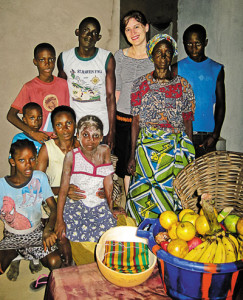
Food insecurity is a major problem for diabetic patients at the Kay Mackensen clinic in Haiti where Julia Von Oettingen, MD (top center) serves as medical director.
For many, it won’t be the first such episode. But for some, it can be the last.
Stories like this are increasingly common across large swaths of the developing world—as Diane Stafford, MD, an endocrinologist from Boston Children’s Hospital, discovered when she traveled to Kigali, Rwanda, through the Human Resources for Health program.
If you’ve paid attention to the news about health care in developing countries in recent decades, you’re likely aware of the huge strides made towards reducing the occurrence of communicable diseases, like HIV/AIDS and malaria and in treating acute conditions. At the same time, however, non-communicable diseases like cancer, diabetes and respiratory conditions are being seen more and more in developing countries.
When chronic becomes acute
The reasons why those diseases are increasing are greatly debated. Researchers have pointed to changes in demographics and diet and increased access to cigarettes among many other factors. As Stafford sees it, however, developing countries may be a victim of their own success: They’re getting better at diagnosing these diseases. “It’s because we’ve gotten so good at treating the acute conditions that we’re now even noticing the occurrence of chronic diseases like diabetes,” she says.
It used to be that few physicians—especially outside of major metropolitan areas—had the training to recognize certain acute conditions as indicators of an advanced, unmanaged chronic problem. In the case of diabetes, physicians often attributed symptoms like excessive thirst and hunger, vomiting, frequent urination and weight loss to malnutrition or an infectious disease. A wrong diagnosis would lead to an incorrect treatment and things only got worse from there. As Stafford explains, “type 1 diabetes is a fatal illness if you don’t recognize it.”
Worse yet, patients who survive acute DKA can become increasingly susceptible to other complications like eye and kidney diseases and skin ulcers. “I have four kids now who are suffering from cataracts,” says Julia von Oettingen, MD, a second-year endocrinology fellow at Boston Children’s and medical director of Kay Mackenson, a clinic that cares for children with non-communicable diseases in Haiti. In industrialized nations, she says, “that’s unheard of in a pediatric diabetes population.”
Recent international collaborations have come a long way toward improving medical education in Rwanda and other developing countries, meaning more and more physicians are recognizing the signs of diabetes and treating it properly.
For the past two years, Stafford and other Boston Children’s physicians have traveled to and from Rwanda as part of an effort aimed at establishing the country’s first pediatric residency program. Stafford spent much of her time there adapting care practices from Boston Children’s and international health organizations for resource-scarce settings.
Not too much, not too little…
Even with improved education, persistent gaps in resources can derail progress, especially in managing a disease like diabetes. Proper diabetes management requires striking the right balance of electrolytes, hormones and nutrients, and not having the equipment to measure nutrients like potassium can pose a danger.
“Potassium shifts a lot as you start to give someone insulin,” Stafford explains. An overdose of potassium can cause muscle weakness and damage heart function, triggering ventricular tachycardia or fibrillation—and eventually cardiac arrest.
Like many hospitals in resource-poor settings, Stafford’s host institution in Kigali had no devices capable of measuring potassium. Part of her role became developing clinical standards that Rwandan physicians could use to work around equipment shortages.
Von Oettingen routinely sees the same problems in Haiti, where she and other clinicians are finding novel ways of meeting chronic care needs in pediatric populations. Through a partnership with the International Diabetes Federation and the Haitian Diabetes Association, the Kay Mackenson clinic has been able to train patients in diabetes self-management skills and provide them with regular care and a safety net to cover emergencies.
Many of the clinic’s patients and their families are unaccustomed to thinking about carbohydrate intake or insulin levels, so self-management education is critical and begins in the hospital. The children are then followed as ambulatory patients, and families have access to an on-call physician around the clock should emergencies arise.
Since the clinic’s opening in January, von Oettingen has trained two local nurses in pediatric diabetes management, established an open-source electronic medical record system she can access from Boston and, like Stafford, provided protocols and flowcharts for managing DKA with available resources.
Though both the Haitian and Rwandan programs are seeing successes, Stafford’s experiences in Kigali often led her to wonder whether she and other clinicians were necessarily doing the right thing. The patients she saw at her host institution got the treatment they needed to survive DKA, but she knew many of them would return to homes lacking regular access to food and testing supplies.
“You get to a point where you ask yourself if you want to treat the acute disease when you know you can’t treat the chronic disease,” she says, “and that’s a really terrible position to be in.”







